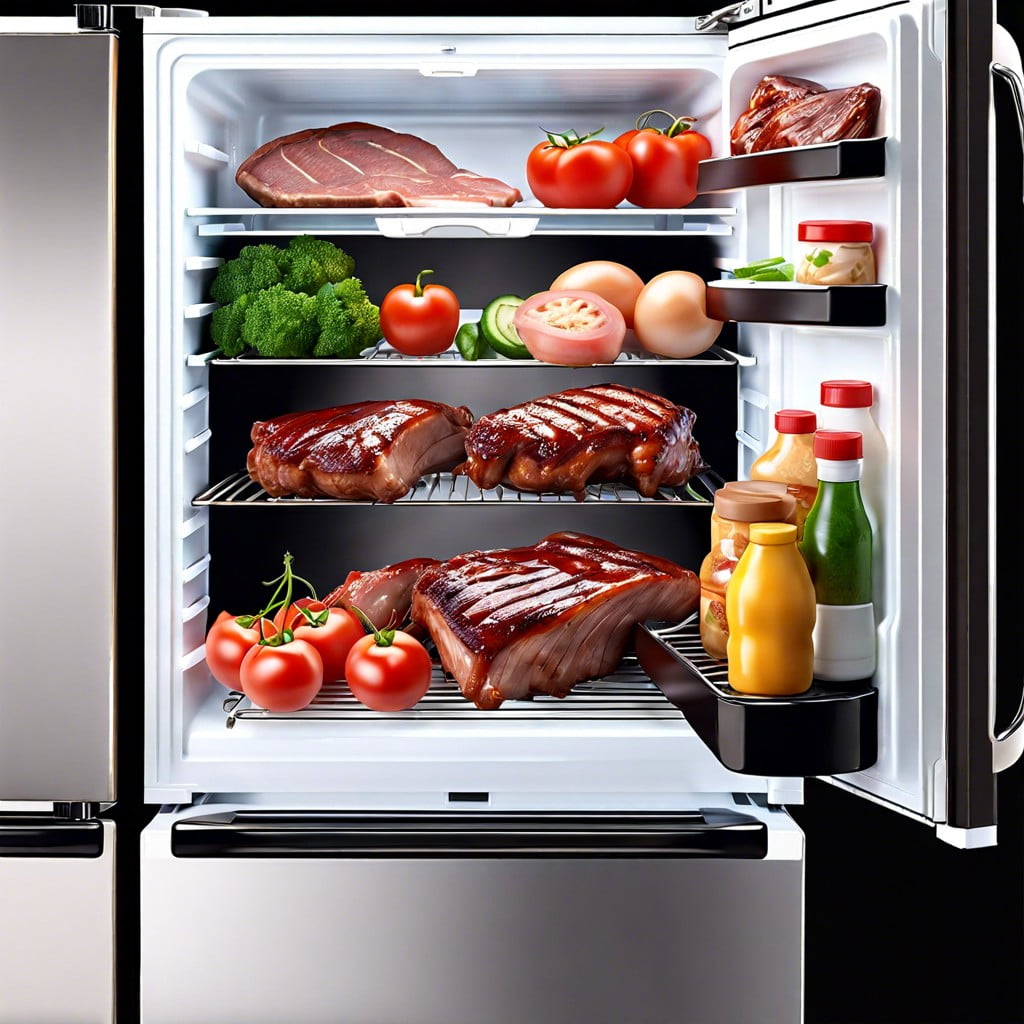Learn how to safely store and determine the shelf life of barbecue in your refrigerator.
Key takeaways:
- Store barbecue in the fridge within 2 hours of cooking.
- Use shallow containers for quick cooling and bacterial growth prevention.
- Choose airtight containers or wrap tightly in foil/plastic to preserve quality.
- Poultry stays fresh for up to 4 days, beef and pork for 3-4 days, sausages and hot dogs for 3-4 days, seafood for 2-3 days.
- Reheat barbecue carefully using oven, microwave, skillet, or low-and-slow methods.
Safe Storage of Barbecue

When it comes to barbecue, prompt storage is vital to maintain quality and ensure safety. Meat should be refrigerated within two hours of cooking, a window that shortens to just one hour if the outside temperature exceeds 90°F. To optimize cooling, divide large portions into smaller, shallow containers that allow for quick temperature reduction.
Ensure your refrigerator is set below 40°F to inhibit bacterial growth, and wrap your barbecue tightly in aluminum foil or plastic wrap, or store it in airtight containers to preserve moisture and flavor while preventing cross-contamination with other foods. Remember, a well-maintained fridge and the correct storage containers are your best allies in extending the enjoyment of your barbecue.
Handling BBQ Leftovers Post-Meal
Once the coals cool and the feast ends, prompt action preserves the flavors and ensures safety:
- Immediately store: Perishable foods shouldn’t linger at room temperature for more than two hours, or one hour if above 90°F.
- Divide for success: Separate large amounts into smaller, shallow containers, this speeds cooling and minimizes bacterial growth risk.
- Airtight etiquette: Use airtight containers or heavy-duty aluminum foil or plastic wrap to keep moisture in and contaminants out.
- Quick chill: Place leftovers in the coldest part of the fridge without overcrowding, permitting air circulation and efficient cooling.
These simple yet critical steps are the foundation for extending the life of your BBQ leftovers while maintaining their quality and safety.
Shelf Life of Different BBQ Meats in the Fridge
When refrigerating smoked or grilled meats, take note of the distinct shelf lives for various types:
- Poultry: Whether it’s chicken or turkey, expect them to stay fresh for up to 4 days.
- Beef and Pork: Ribs, brisket, or pulled pork are at their best quality within 3 to 4 days.
- Sausages and Hot Dogs: These typically last 3 to 4 days, but check for any changes in odor or texture as cues to discard.
- Seafood: It has a shorter refrigerator life; consume smoked fish or shrimp within 2 to 3 days.
In all cases, ensure that the meat is stored in airtight containers or tightly wrapped to prevent the spread of odors and preserve moisture. If you’re uncertain about the freshness, look for common spoilage signs such as a slimy texture, sour smell, or discoloration. When in doubt, it’s safer to err on the side of caution and dispose of any questionable leftovers.
How to Reheat Barbecue Safely
Reheating barbecue carefully preserves texture and flavor while ensuring food safety. Use these points to reheat your BBQ effectively:
- Oven Method: Preheat to 250°F, wrap meat in foil to retain moisture, and heat until it reaches an internal temperature of 165°F.
- Microwave Technique: Use a microwave-safe container, cover with a damp paper towel to keep the meat moist, and use the reheat setting or medium power to avoid drying out the meat.
- Skillet Approach: Use medium heat for sliced meats, turning frequently to prevent burning. Add a splash of water or broth to keep it tender.
- Reheating Low-and-Slow: If dealing with large BBQ cuts, consider reheating in a smoker or oven at a low temperature (225°F), to slowly bring it up to temperature without overcooking.
- Avoid Direct High Heat: High heat can quickly dry out BBQ, stripping it of flavor and juiciness, so always opt for gentler reheating methods.
Remember, add barbecue sauce only after your meat is heated through to avoid burning the sugars in the sauce. Always check the temperature with a meat thermometer.
Essential Tips for Refrigerating BBQ Sauces
When preserving the zest and flavor of BBQ sauces in the refrigerator, it’s crucial to utilize airtight containers, preventing oxidation and contamination. Glass jars with tight lids are ideal for this purpose, ensuring freshness is maintained. If the sauce comes in its original bottle with a secure cap, you may continue using it, provided it seals correctly.
Temperature plays a significant role in the longevity of BBQ sauces; keep them stored at or below 40°F. This temperature halts bacterial growth, keeping sauces safe for consumption. Always ensure the refrigerated sauce is not placed on the door shelf, as temperatures here fluctuate, potentially compromising the sauce’s quality.
Cross-contamination can spoil sauces. Never dip used utensils into the sauce container; instead, pour the amount you’ll use into a separate dish. This prevents bacteria from cooked meats from mingling with the sauce. Remember, after serving, don’t return unused sauce that’s come into contact with food or utensils back to the original container.
Acidity in BBQ sauces acts as a natural preservative. Vinegar or tomato-based sauces typically have a longer fridge life, lasting up to four weeks, due to their higher acidity levels. Creamier or mayonnaise-based sauces need a bit more caution, usually remaining good for up to one week.
Finally, trust your senses. If a BBQ sauce develops an off-odor, changes color, or shows any signs of mold, discard it immediately to avoid the risk of foodborne illnesses.

